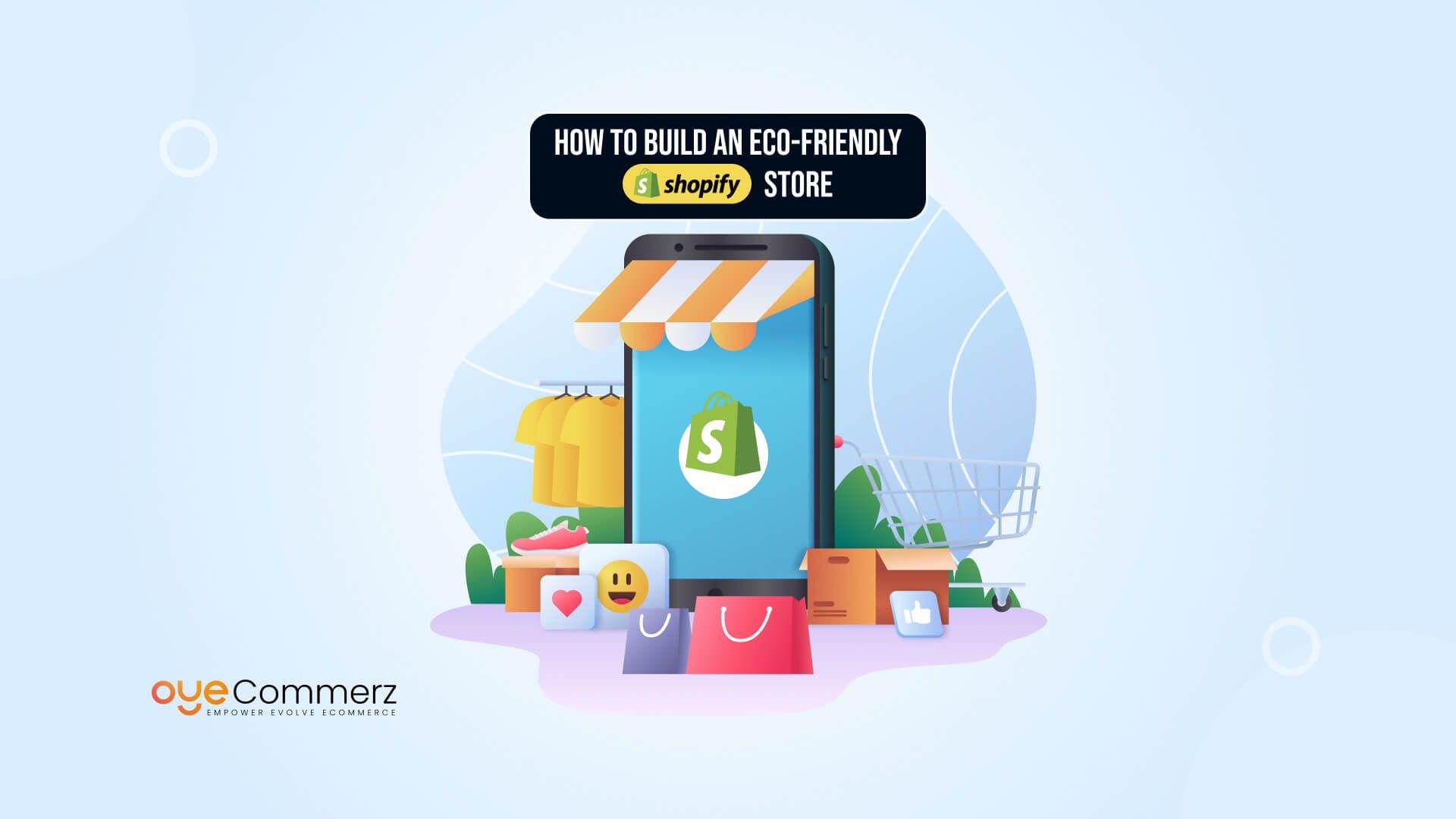E-commerce is booming, but at what cost? As online shopping becomes a default habit across the globe, so does the environmental footprint it leaves behind, from excess packaging and emissions-heavy shipping to unsustainable product sourcing. Amid this growth, a new wave of consumers is demanding more than just convenience. They want conscious choices, ethical brands, and a future-focused mindset.
This shift has opened the door to a powerful opportunity: building your brand on the foundation of sustainable e-commerce. Consumers today are more willing to support businesses that prioritize the planet alongside profit. And if you’re using Shopify, you’re already one step ahead. Shopify’s flexible ecosystem offers the tools, apps, and integrations to transform your online store into an eco-friendly operation without compromising performance.
In this blog, we’ll walk you through actionable, step-by-step strategies to build a truly eco-friendly Shopify store, one that benefits your business, your customers, and the planet.
Table of Contents
ToggleWhy Sustainability in E-Commerce Can’t Be Ignored
The rapid rise of online shopping has reshaped the retail landscape, but it’s also left a visible mark on the environment. From single-use plastic packaging to emissions from global shipping, the convenience of e-commerce has a hidden cost. Behind every doorstep delivery is a supply chain that contributes to waste, pollution, and carbon emissions.
Consider the following environmental impacts:
- Packaging waste: Cardboard boxes, bubble wrap, plastic fillers—most of which are discarded within minutes.
- Excessive shipping emissions: Fast shipping and global distribution create a sizable carbon footprint.
- Returns and overproduction: Inconsistent sizing or impulse buying leads to unnecessary returns, which often don’t get resold.
These issues aren’t invisible to today’s customers. In fact, a recent study by IBM found that 57% of consumers are willing to change their purchasing habits to help reduce negative environmental impact. The demand for transparency, ethical practices, and greener alternatives is no longer niche, it’s mainstream.
That’s why sustainable e-commerce isn’t just about reducing your carbon footprint; it’s about aligning with the expectations of a growing majority. Today’s shoppers care about how products are made, shipped, and disposed of. Brands that embrace this shift not only support the planet, they also gain deeper loyalty, stronger brand value, and better long-term growth.
Platforms like Shopify make it easier than ever to pivot toward more responsible practices. Whether it’s through eco-conscious packaging options or carbon offset integrations, an eco-friendly Shopify store isn’t just possible, it’s powerful.
In the next section, we’ll explore what really defines an eco-friendly store and how you can lay the right foundation from the start.
What Makes a Shopify Store “Eco-Friendly”?
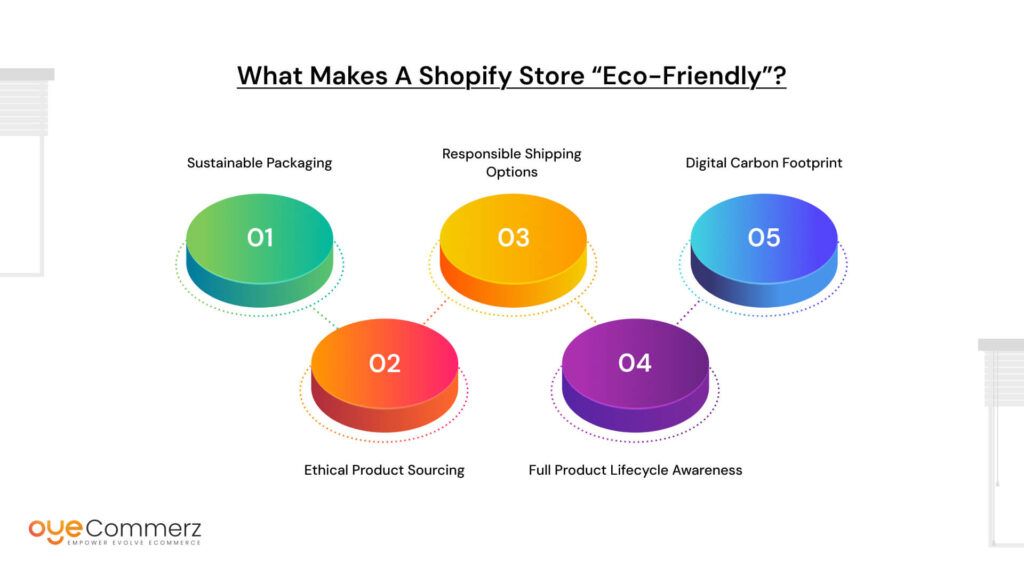
When we talk about an eco-friendly store, we’re not just referring to recyclable packaging or carbon offsetting. An eco-friendly Shopify store is one that approaches its entire business model, from sourcing to delivery, with sustainability in mind. It’s a holistic mindset, not a one-off marketing feature.
Here’s what that looks like in practice:
Sustainable Packaging
Swap out plastic-based packaging for compostable mailers, recycled materials, or reusable options. Less is more, streamlined, minimal packaging is both cost-effective and better for the environment.
Ethical Product Sourcing
Eco-friendly stores work with suppliers who prioritize fair labor, low-impact materials, and ethical production. Transparency in where and how products are made plays a big role in building trust.
Responsible Shipping Options
Fast shipping can be damaging to the environment. Offer customers slower, consolidated delivery as a green option. Consider partnering with carriers that use electric vehicles or offset emissions.
Full Product Lifecycle Awareness
Think beyond the sale. Can the product be reused, repaired, or recycled? Offering repair guides or buy-back programs shows that your brand values long-term impact.
Digital Carbon Footprint
Even your website has a footprint. A clean, lightweight design reduces the energy used to load your pages. Optimized images, minimal plugins, and efficient code all contribute to a leaner digital presence.
So, why Shopify? It’s one of the most customizable and scalable platforms available, with a growing suite of apps and integrations that specifically support green practices. From apps that help track your store’s emissions to plugins for sustainable packaging options, Shopify allows you to build with intention, without sacrificing functionality.
Creating a sustainable e-commerce business may sound complex, but it starts with clear values and smart tools. In the next section, we’ll explore how to begin setting up your store with the planet in mind, step by step.
Step-by-Step: Building a Sustainable E-Commerce Store on Shopify

Creating a truly eco-friendly Shopify store requires more than just a green tagline. It’s about aligning every part of your business with environmental responsibility, from the products you sell to how you deliver them.
Choose a Green Product Niche
The first step toward a sustainable e-commerce store is choosing what to sell. Opt for products that support reusability, minimalism, and zero-waste lifestyles. Think bamboo toothbrushes, refillable skincare products, upcycled clothing, or biodegradable cleaning tools.
For example, instead of selling regular notebooks, offer stone paper journals or plantable seed paper. If you’re in fashion, consider working with upcycled fabric artisans. Shopify makes it easy to validate demand using integrated apps for SEO and product research, so you don’t have to guess consumer interest.
The key here is to balance profitability with values. You can be ethical and smart. Choose a product line that serves both the planet and your audience’s needs.
Vet Your Supply Chain
A truly eco-friendly Shopify store begins with ethical sourcing. Dive deep into your supply chain. Are your products made in safe working conditions? Are the raw materials sustainable?
Ask suppliers questions like:
- What are your labor practices?
- Do you use renewable or organic materials?
- Can you provide third-party certifications?
Look for certifications like:
- FSC (Forest Stewardship Council)
- GOTS (Global Organic Textile Standard)
- Fair Trade Certified
For example, if you’re selling cotton bags, opt for suppliers who are GOTS-certified and pay fair wages to workers. Vetting may take time, but it builds long-term brand trust. Use Shopify’s supplier management apps to track and verify ethical sourcing. Building a sustainable e-commerce store means knowing your products’ journey before they reach your customer.
Sustainable Packaging Strategies
Packaging is the most visible form of waste. To stay true to your eco-friendly Shopify mission, focus on packaging that protects the planet. Compostable mailers, recycled cardboard, paper tape, and soy-based inks are all strong choices.
Top vendors to consider:
- noissue (custom compostable mailers)
- EcoEnclose (recycled and reusable options)
- Better Packaging Co. (certified sustainable)
Yes, sustainable packaging may cost more upfront. But the positive customer perception and reduced waste make it worthwhile. For example, a skincare brand using glass jars and compostable filler sends a message that resonates far deeper than plastic alternatives.
Shopify makes it easy to list your packaging practices clearly on product pages or in your FAQ. Sustainable packaging is not just a feature, it’s a statement.
Green Shipping Options
Shipping is another big player in e-commerce emissions. Consider carbon-neutral shipping programs to reduce impact.
Ways to make your sustainable e-commerce shipping greener:
- Offer local pickup where possible
- Encourage slower shipping (less fuel consumption)
- Bundle shipments into fewer deliveries
Shopify supports tools like Shopify Planet, EcoCart, and Offset to help stores measure and offset shipping emissions. For example, with Planet by Shopify, you can automatically donate to carbon removal programs every time a customer checks out.
Be transparent with your shipping approach. Adding a “Green Shipping” badge or banner builds credibility. An eco-friendly store doesn’t have to offer next-day delivery, it should offer next-decade thinking.
Design for Digital Sustainability
A sustainable brand isn’t just about physical goods. Even your website uses energy.
Tips to reduce your eco-friendly Shopify store’s digital carbon footprint:
- Use compressed, optimized images
- Choose clean, minimalist themes
- Avoid heavy animation and unnecessary pop-ups
A faster site isn’t just greener, it improves UX and SEO. Shopify offers lightweight themes like Dawn or Craft, which are optimized for speed and simplicity.
Example: A fashion store with high-res images can switch to WebP formats and save bandwidth. Add lazy loading to defer images until they’re needed. All this cuts server strain and power usage.
Think of your digital space like your physical one: clean, efficient, and intentional.
Build Transparency into Your Brand
Transparency is the backbone of trust in sustainable e-commerce. Customers want to know what you stand for and how you’re making a difference.
Ways to infuse transparency:
- Share your mission on your homepage
- Create a dedicated “Impact” or “Sustainability” page
- Show real stories behind your products
For example, if you source from a women-led cooperative in India, tell that story. If your packaging saved X pounds of plastic last year, share that stat. Shopify’s flexible CMS lets you build beautiful landing pages with embedded visuals, impact reports, and testimonials.
The more honest you are, the more customers will stick around. An eco-friendly store isn’t perfect, it’s evolving. And letting your audience in on that journey builds brand loyalty.
Eco-Friendly Apps and Shopify Integrations
Shopify’s ecosystem is rich with tools designed to support sustainable e-commerce.
Top app recommendations:
- EcoCart – Adds a carbon offset option at checkout
- Planet by Shopify – Automates carbon removal contributions
- Green Story – Adds sustainability labels to your products
These apps integrate seamlessly with your store and provide real-time impact tracking. For example, EcoCart can show a customer how their purchase contributes to reforestation or clean water projects.
When evaluating apps, ask:
- Does it align with your mission?
- Is it user-friendly and transparent?
- Can results be tracked or reported?
A truly eco-friendly store uses technology not just for sales, but for meaningful impact.
Optimize Returns & Reduce Waste
Returns create hidden environmental costs, extra shipping, restocking, and often disposal.
- Use Shopify apps with virtual try-on tools (for eyewear, cosmetics, apparel)
- Incentivize exchanges over returns
- Create detailed sizing charts and product FAQs
For instance, a clothing brand offering a 10% discount for choosing an exchange keeps the sale while reducing shipping emissions.
Virtual tools like Zeekit or Fit Finder help customers choose right the first time. Fewer mistakes = fewer returns.
Your sustainable e-commerce goal should be waste prevention, not just management. Shopify apps can track common return reasons so you can improve listings and product descriptions.
Reducing returns isn’t just good for the environment, it’s good for your bottom line.
Marketing Your Sustainable Shopify Store
Building an eco-conscious brand doesn’t stop at setting up a responsible store, it’s equally important to share your values in ways that resonate. Today’s shoppers don’t just buy products; they buy into stories, missions, and movements. Effective marketing for a sustainable Shopify store begins with authenticity.
Start by weaving your environmental commitment into your brand narrative. Don’t just mention it in passing, make it a core part of how you speak to your audience. Show them what goes on behind the scenes: how your products are made, the packaging choices you’ve debated, or the challenges you’ve overcome. This kind of transparency doesn’t just build trust, it builds loyalty.
Powerful ways to market authentically:
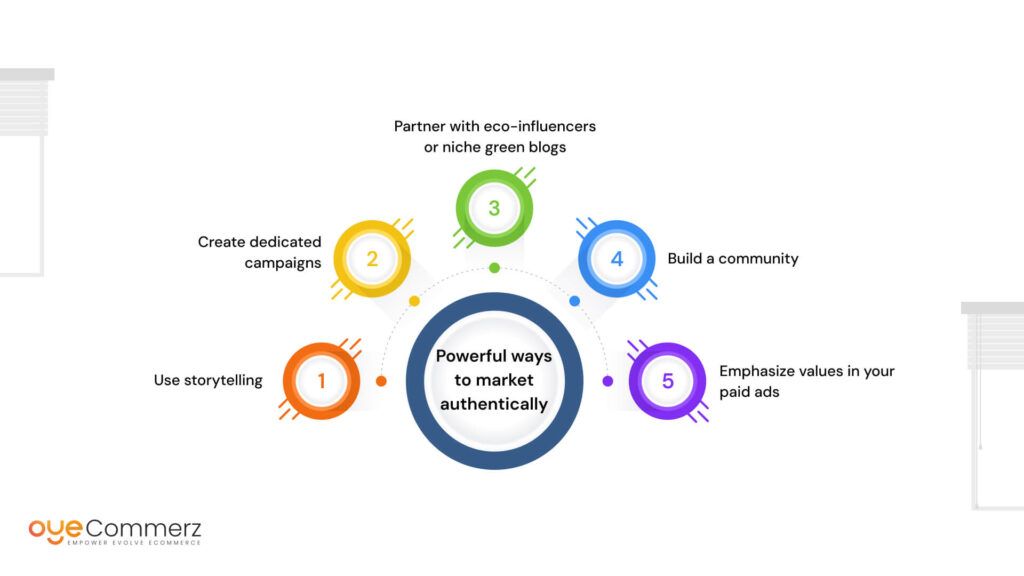
- Use storytelling in your emails and social media to highlight real efforts toward sustainability. Feature supplier stories, eco-friendly packaging decisions, or your team’s commitment to reducing waste.
- Create dedicated campaigns around globally recognized eco-events like Earth Day, Plastic-Free July, or World Environment Day to stay top-of-mind with like-minded consumers.
- Partner with eco-influencers or niche green blogs who align with your mission. Their audiences already care about ethical shopping and are more likely to support your store.
- Build a community around sustainability-focused content. Start a blog or video series educating shoppers on topics like conscious consumption, zero-waste tips, or product care to extend lifecycle.
- Emphasize values in your paid ads, targeting people based on ethical consumer behavior and promoting the positive impact of supporting your store.
Tracking and Measuring Your Eco Impact
Once you’ve created your eco-friendly Shopify store, the next step is to track and measure the impact you’re having. This ensures you stay accountable to your sustainability goals while showing your customers that you’re delivering on your promises. Thankfully, various tools can help you monitor your efforts.
Key tools to track your eco impact:
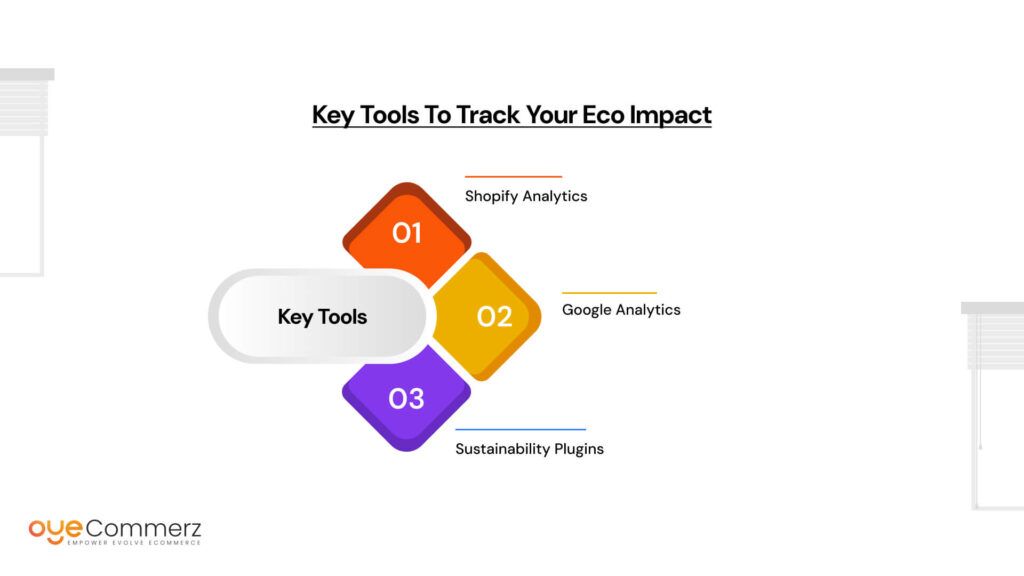
- Shopify Analytics: This built-in tool can help you understand product performance, customer behavior, and sales trends, enabling you to see how your eco-friendly items are performing.
- Google Analytics: While this tool focuses on web traffic and user engagement, it can also track the effectiveness of sustainability-focused campaigns or blogs that educate customers on eco-friendly shopping.
- Sustainability Plugins: Apps like EcoCart or Planet by Shopify help calculate and offset your store’s carbon footprint, track carbon credits, and highlight the sustainable aspects of your products.
Metrics to monitor:
- Packaging waste saved: Measure how much waste you’ve avoided by using sustainable materials.
- Carbon offsets purchased: Keep track of the offsets you’ve bought to neutralize emissions from shipping and manufacturing.
- % of eco-materials used: Document the percentage of your products made from organic, recycled, or sustainable materials.
Displaying these metrics on your website, perhaps through a dedicated “Sustainability Impact” page, shows customers that you take your eco-friendly claims seriously. Transparency in how you’re improving makes your store more authentic and trustworthy in the eyes of ethical shoppers.
Common Mistakes to Avoid
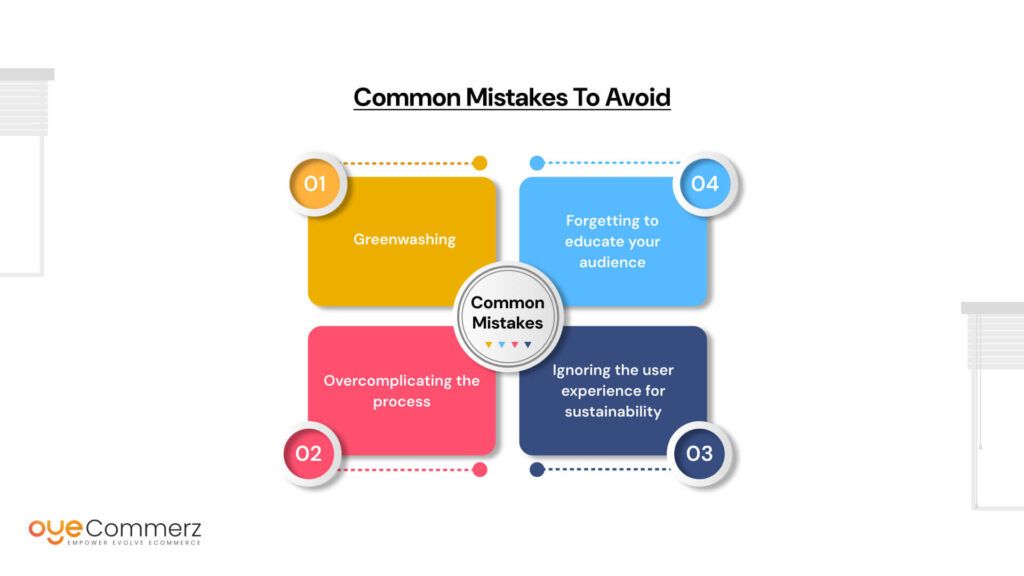
Building a successful, sustainable Shopify store comes with its share of challenges. While the journey is rewarding, there are common pitfalls you need to avoid in order to stay credible and successful in the eco-friendly ecommerce space.
Greenwashing:
Promising to be sustainable without backing it up is one of the quickest ways to lose consumer trust. If your claims don’t align with your actual practices, customers will quickly see through it. Make sure your actions and claims are transparent and measurable.
Overcomplicating the process:
Many entrepreneurs get overwhelmed by the idea of being “perfect” right from the start. Remember, sustainable e-commerce is a journey. Begin with small, impactful changes like switching to eco-friendly packaging or sourcing sustainable products. Overcomplicating it can create unnecessary barriers.
Ignoring the user experience for sustainability:
While it’s crucial to focus on sustainability, you mustn’t forget the importance of a smooth and easy shopping experience. Offering a cluttered website or inconvenient checkout process can drive customers away, even if your products are eco-friendly.
Forgetting to educate your audience:
Consumers are becoming more conscious of sustainability, but they still need guidance. Use your website, social media, and email campaigns to educate your customers about your green initiatives, why they matter, and how they can contribute to positive environmental change.
By avoiding these common mistakes, you’ll stay on track and create an authentic, sustainable e-commerce store that customers can trust.
Ready to turn your e-commerce vision into reality?
OyeCommerz helps you build powerful, scalable, and sustainable online stores that stand out. From seamless Shopify setups to custom integrations, we’ve got you covered. Let’s grow your brand the smart way.
Let's build your custom Shopify app today!
Conclusion
Migrating from Magento to Shopify product migration may seem overwhelming at first, but with the right preparation, it becomes a manageable and valuable process. While it requires careful planning and execution, businesses don’t need to be tech-savvy to successfully migrate Magento to Shopify. The key is focusing on strategic priorities like scalability, performance, and optimizing the customer experience.
Shopify provides a user-friendly environment with advanced features that ensure long-term growth and adaptability. With the Migration services, right tools and approach, this transition can empower your business to thrive in an ever-evolving e-commerce landscape. Prioritize these aspects, and you’ll set your store up for sustained success and growth.
Frequently Asked Questions
Shopify supports sustainability through features like carbon-neutral shipping (Shopify Planet) and eco-friendly apps, but the platform’s environmental impact depends on how store owners use it.
It’s tough to be 100% eco-friendly, but you can get close by using sustainable products, ethical suppliers, renewable energy, minimal packaging, and carbon offsetting.
E-commerce can be sustainable by reducing physical retail footprints, using eco-packaging, optimizing delivery routes, and selling ethically made, low-impact products.
Stores can go green by using recycled packaging, sourcing sustainably, reducing energy use, offering carbon-neutral shipping, and educating customers about their impact.
Major issues include excess packaging waste, carbon emissions from shipping, high return rates, and energy use from servers and data centers.

